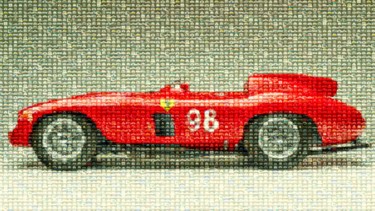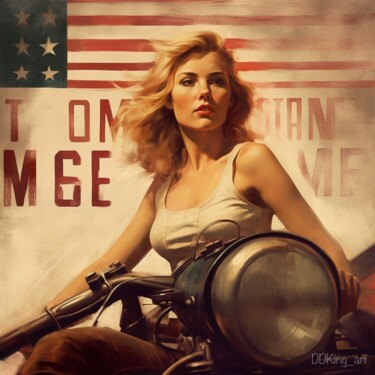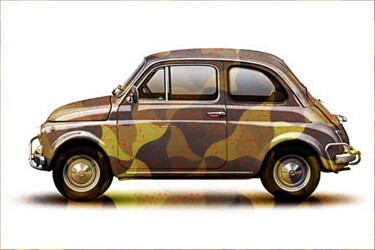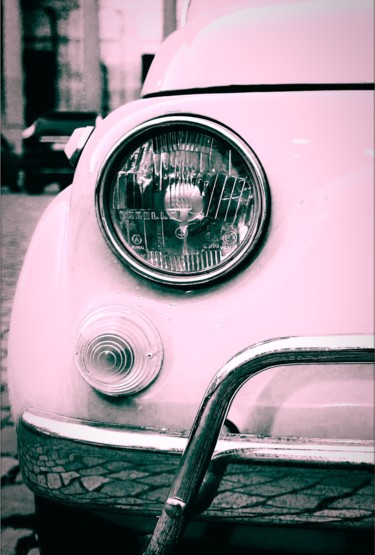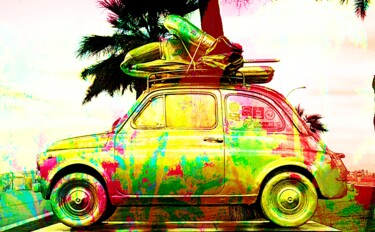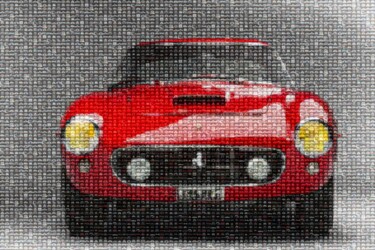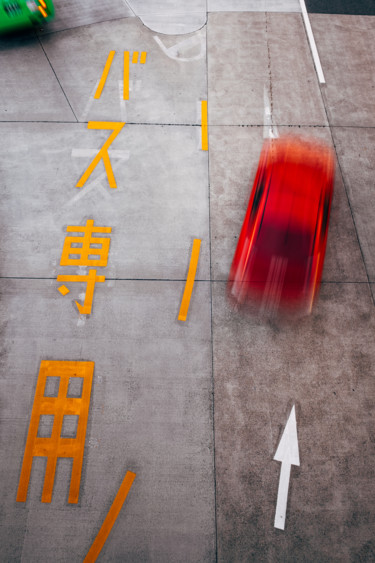12 Original artworks, Limited Editions & Prints:
Conceptual art, often known as conceptualism, is art in which the underlying idea or concept is more relevant than the final product. Conceptual artists created works and writings between the middle of the 1960s and the middle of the 1970s that fundamentally rejected conventional notions of art.
To convey their ideas, conceptual artists chose the media and formats that worked best for them. This led to a wide variety of artworks that might resemble anything, from performances to writing to everyday objects. The artists used unseen systems, structures, and processes, as well as linguistic, mathematical, and process-oriented elements of mind, to investigate the possibilities of art as concept and art as knowledge. Some conceptual art pieces, also known as installations, can be created by anyone simply according to a set of written instructions.
The question of artistic ability is a key distinction between conceptual art and more "conventional" types of art-making. Although expertise in the use of traditional media frequently plays a little role in conceptual art, it is difficult to claim that conceptual works always lack talent or that skill is not necessary to create them.
The origins of Conceptual Art
It's widely known that Marcel Duchamp founded conceptual art. Although the term "conceptual art" wasn't coined until the 1960s, the movement's roots may be found in 1917, when Marcel Duchamp famously purchased a urinal from a plumbing store and entered it as a sculpture in a New York open sculpture exhibition. The jury disqualified the piece because they thought it was immoral and wouldn't accept it as art. Duchamp created the path for Conceptual art by exploration of the limits of art and critique of the art world. Later, American artist Joseph Kosuth acknowledged Duchamp's relevance and theoretical significance for upcoming "conceptualists" in his 1969 essay, Art after Philosophy, in which he stated: "All art (after Duchamp) is conceptual (in nature) because art only exists conceptually."
Members of the Fluxus movement were already using the term "concept art" from the beginning of the 1960s. The movement's main goal was to break away from modernism's exclusivity and promote an open attitude toward art. Artists involved in the Fluxus movement were interested in expanding the aesthetic's points of reference to include anything, from an object to a sound or an action. Fluxus is unquestionably one of Conceptual art's influences, even though it isn't always considered to be a part of the movement. It was a significant trend on par with conceptualism, and its practitioners are frequently referred to as conceptual artists.
In part as a response to formalism as it was then described by the famous New York art critic Clement Greenberg, conceptual art arose as a movement in the 1960s. According to Greenberg, modern art pursued the objective of establishing the fundamental, formal nature of each media through a process of continual reduction and refinement. The components that were in opposition to this nature had to be minimized. For instance, the job of painting was to properly describe what kind of object a painting is, and nothing else: what makes it a painting and nothing else.
Others, including many of the artists themselves, saw conceptual art as a fundamental break from Greenberg's type of formalist Modernism. Some have suggested that conceptual art extended this "dematerialization" of art by eliminating the necessity for things completely. Later artists had the same dislike for illusion and preference for art that is self-critical.
By the end of the 1960s, it was evident that Greenberg's rules for keeping art within the parameters of each medium and excluding extraneous subject matter were no longer valid. In an effort to undermine the gallery or museum as the setting and arbiter of art as well as the art market as the owner and seller of art, conceptual art also responded against the commercialisation of art.
Language based art
The primary concern of the first generation of conceptual artists in the 1960s and early 1970s was language. Although using text in art was nothing new, it wasn't until the 1960s that artists like Lawrence Weiner, Edward Ruscha, Joseph Kosuth, Robert Barry, and Art & Language started making art solely through language. The conceptual artists employed language in place of brush and canvas and gave it the freedom to signify on its own, as opposed to the past where language was portrayed as one type of visual element among others and subordinate to an overall composition (such as Synthetic Cubism).
The turn to linguistic theories of meaning in both Anglo-American analytic philosophy and structuralist and post structuralist Continental philosophy during the middle of the 20th century, according to British philosopher and conceptual art theorist Peter Osborne, was one of the many factors that influenced the gravitation toward language-based art. This linguistic shift "supported and legitimized" the conceptual artists' choice of path. The early conceptualists were the first generation of artists to complete degree-based academic training in art, according to Osborne. In a later public lecture, Osborne stated that contemporary art is post-conceptual. It is a claim made in relation to the ontology of the artistic production (rather than say at the descriptive level of style or movement).
Famous conceptual artists
Joseph Beuys
German artist Joseph Beuys (1921 -1986), active in Europe and the US from the 1950s to the early 1980s, became known for his work in the international Conceptual art and Fluxus movements of that time. Beuys' extensive body of work encompasses both traditional media like drawing, painting, and sculpture as well as process-oriented or time-based "action" art, the performance of which suggested how art may have a healing effect when it addresses psychological, social, or political issues (on both the artist and the audience).
Joseph Kosuth
Joseph Kosuth (b. 1945) is an American conceptual artist and theoretician. In the middle of the 1960s, Joseph Kosuth was one of the founders of conceptual art, which grew into a significant movement that flourished into the 1970s and continues to have an impact today. He examined the relationship between ideas and the images and words used to convey them and was a pioneer in the use of words in place of visual imagery of any type. He has created various site-specific installations since the 1970s that continue to investigate how humans experience, understand, and react to words.
Sol LeWitt
Sol LeWitt (1928 - 2007) was an American conceptual artist and painter. Due to his leading role in the Conceptual movement, he earned a place in the annals of art history. His faith in the creative process of the artist played a crucial role in the shift from the modern to the postmodern periods. LeWitt's definition of conceptual art as an intellectual, pragmatic act provided a fresh facet to the artist's job that was significantly distinct from the romanticism of Abstract Expressionism. LeWitt's artwork included sculpture, painting, and drawing in addition to virtually entirely conceptual creations that were merely concepts or components of the creative process.
Robert Smithson
More young artists have been influenced by Robert Smithson (1938–1973) than perhaps any other member of the group that developed in the 1960s. He was a talented artist and writer whose interests included science fiction, mineralogy, and Catholicism. Early works by him included collages and paintings, but he soon turned his attention to sculpture in response to the Minimalism and Conceptualism of the early 1960s. He also began to take his art outside of galleries and into the landscape.
Damien Hirst
Damien Hirst (b. 1965) is an English artist, the art icon of the 1990s and one of the biggest provocateurs of the late 20th century as well as a divisive figure in contemporary art history. Charles Saatchi, an advertising magnate who recognized potential in Hirst's decomposing animal corpses and gave him an almost unlimited cash to continue, helped the young and essentially unknown artist rise far and quickly.
The topic of death dominates many of Hirst's pieces. He became famous for a body of work that featured preserved, occasionally dissected, dead animals in formaldehyde, including a shark, sheep, and cow. The most well-known of them was a 4.3 m long formaldehyde-immersed tiger shark in a glass exhibition case called The Physical Impossibility of Death in the Mind of Someone Living.
For a living artist, Hirst created history in September 2008 when he bypassed his longtime galleries and sold the entirety of his exhibition, Beautiful Inside My Head Forever, at Sotheby's by auction. The auction broke the record for a single-artist auction by raising £111 million ($198 million).
Walter de Maria
Walter de Maria (1935 - 2013) was an American sculptor and conceptual artist. Walter de Maria created interactive sculpture installations and provided conceptual support for larger-scale sculptural works, bridging several artistic practice groups that grew in popularity in the 1960s. In later works, he also created connections between viewers and the natural world by either incorporating visual aspects into the environment itself or integrating natural elements into gallery settings. His most ambitious works were very large-scale not only in terms of physical size but also in terms of exhibition duration, with some lasting decades both inside and outside.
Jenny Holzer
Jenny Holzer (b. 1950) is an American neo-conceptual artist. Her work primarily focuses on communicating ideas and words in public settings and includes large-scale installations, advertising billboards, projections on buildings and other structures, and illuminated electronic displays. Jenny Holzer's text-based artwork can be found in unexpected places: on t-shirts, billboards, parking meters and LED signs (Holzer's trademark medium).
Artist and political activist Holzer wants to stop people from passively consuming information from unfavorable sources. The ambition and scale of her art, which has been displayed in public locations across much of the globe, have expanded along with her reputation. Holzer joins the ranks of anti-authoritarians in art from the beginning of modernism (which is essentially a struggle against tradition) through the twenty-first century in her strong cynicism of power.
Lawrence Weiner
Lawrence Weiner (1942 - 2001) was an American conceptual artist and one of the pioneers of text-as-art during the era of Conceptualism. His use of words is remarkable for its poetry, its curious contact with the real world, and its distinctive, frequently vibrant, and often humorous visual forms. Working-class artist Weiner considered his paintings as invitations for viewers to reevaluate their relationships with the world around them, particularly with other people and systems of power.
Conceptual artists quotes
Sol LeWitt
“In conceptual art the idea or concept is the most important aspect of the work. When an artist uses a conceptual form of art, it means that all of the planning and decisions are made beforehand and the execution is a perfunctory affair. The idea becomes a machine that makes the art.”
“New materials are one of the great afflictions of contemporary art. Some artists confuse new materials with new ideas.”
“Artists teach critics what to think. Critics repeat what the artists teach them.”
“In conceptual art the idea or concept is the most important aspect of the work”
Joseph Kosuth
“Anything can be art. Art is the relations between relations, not the relations between objects.”
“All art (after Duchamp) is conceptual (in nature) because art only exists conceptually.”
Damien Hirst
“You need a big ego to be an artist.”
“Museums are for dead artists. I'd never show my work in the Tate. You'd never get me in that place.”
Walter de Maria
"I think to be a true minimalist you should almost nearly be invisible yourself."
"Every good work should have at least ten meanings."
Jenny Holzer
“Lack of charisma can be fatal.”
“Being happy is more important than anything else.”
“All things are delicately interconnected.”
“You are a victim of the rules you live by.”
Lawrence Weiner
“The only art I'm interested in is the art I don't understand right away. If you understand it right away it really has no use except as nostalgia.”
Where to buy art by Belgian artists?
Artmajeur presents a selection of the best Contemporary Belgian artists: Belgian painters, Belgian sculptors, Belgian photographers, you can find both emerging and confirmed artists on the gallery.
While painters, sculptors and photographers from Belgium are the most popular techniques, we also have great contemporary works for sale in other techniques like collages, digital arts or textile arts. Artmajeur gallery is very popular in Belgium because many contemporary artists use it to sell their artworks: collectors looking to buy art by Belgian artists can find a great diversity of techniques, colors, styles and prices.
From Brussels to Ghent, via Charleroi, Liège and Antwerp, Belgium has always been a formidable artistic cradle. The country of surrealism, nicknamed thus because of its illustrious representatives such as René Magritte, Paul Nougé, Achille Chavée, Ferdinand Dumont or even Christian Dotremont, is full of emblematic works of European artistic culture, from Manneken-Pis to The Death of Marat by Jacques-Louis David, through The Census of Bethlehem by Pieter Brueghel the Elder. Whether Flemish or Walloon, sculptors, painters or photographers, many Belgian artists have marked the history of their name: Jan van Eyck, Pieter Paul Rubens, Jacob Jordaens, Anne Teresa de Keersmaeker, Jan Fabre, Hans Memling, Félicien Rops, Luc Tuymans, Paul Delvaux, James Ensor, or even the intriguing sculptor Panamarenko.
Discover contemporary Artworks on Artmajeur
Contemporary art is a vibrant constellation of artistic expressions. This creative universe encompasses a wide array of mediums, from paintings, sculpture, and photography to drawing, printmaking, textile art, and digital art, each medium a star shining with its own distinct radiance. Artists use diverse supports and materials to bring their visions to life, such as canvas, wood, metal, and even innovative digital canvases for the creation of virtual masterpieces.
A contemporary painting, for instance, may weave its story through the masterful strokes of acrylic or oil, while a contemporary sculpture might sing its song in the language of stone, bronze, or found objects. The photographic arts capture and manipulate light to produce striking images, while printmaking employs techniques like lithography and screen-printing to produce multiples of a single, impactful image. Textile art plays with fabrics and fibers, whereas digital art pushes the boundaries of creation with innovative technology.
The allure of contemporary art lies in its boundary-pushing nature, its relentless quest for experimentation and its constant reflection of the evolving human experience. This boundless creativity, coupled with its strong social and personal commentary, makes every piece of contemporary art a unique emblem of its time, a mirror held up to the realities and dreams of our complex world. It whispers to us, moves us, provokes thought, and kindles a deep emotional response, stirring the soul of anyone willing to listen. It is, indeed, the language of emotions and ideas, spoken in the dialect of our era.
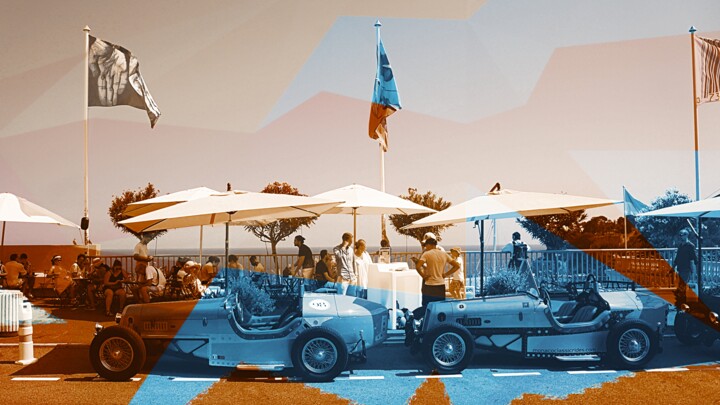
©2023 Gaudi .C
Origins and history of contemporary art
The story of contemporary art unfolds in the mid-20th century, marked by seismic shifts in artistic expression. Post-World War II, around the 1950s and 1960s, artists began experimenting beyond traditional confines, challenging the norms of what art could be. This revolutionary epoch birthed myriad new movements and artistic forms such as abstract expressionism, pop art, and minimalism. Paintings, once confined by realism, embraced abstraction, as artists used color and form to express emotions and ideas. Notable periods like the advent of pop art in the late 1950s and early 1960s saw artworks mimicking popular culture and mass media, reflecting society’s shifting focus.
The sculptural arts, too, witnessed a metamorphosis. Sculptors started to experiment with new materials and forms, often creating artworks that interacted with the viewer and the surrounding space, fostering a sense of engagement. Drawing, a timeless practice, also evolved, with artists incorporating innovative techniques and concepts to redefine its role in contemporary art.
Photography, a relatively new medium, emerged as a powerful tool in the contemporary art landscape. Born in the 19th century, it truly came into its own in the latter half of the 20th century, blurring the lines between fine art and documentation. Printmaking, a practice dating back to ancient times, saw renewed interest and experimentation with techniques like lithography, etching, and screen printing gaining prominence.
The realm of textile art expanded dramatically, as artists began to appreciate the versatility and tactile quality of fabric and fibers. Artists began using textiles to challenge the boundaries between fine art, craft, and design.
The dawn of digital technology in the late 20th century heralded a new age for contemporary art. Digital art emerged as artists started leveraging new technologies to create immersive, interactive experiences, often blurring the line between the virtual and the physical world.
Through these transformative periods, the essence of contemporary art has remained the same: a dynamic, evolving reflection of the times we live in, continually pushing boundaries and embracing the new, always questioning, always exploring.

©2023 Gaudi .C
Evolutions of theses contemporary works in the art market
As we navigate through the 21st century, the dynamic landscape of contemporary art continues to evolve and expand, reflecting our ever-changing world. Contemporary paintings, once primarily confined to two-dimensional canvases, now embrace a multitude of forms and techniques, ranging from mixed media installations to digital creations, each piece a rich a weaving of thoughts, emotions, and narratives. Sculpture, too, has ventured far beyond traditional stone and bronze, with artists incorporating light, sound, and even motion, embodying the ephemerality and flux of the modern world.
Photography, in the hands of Contemporary Artists, has expanded its horizons, seamlessly blending with digital technology to create breathtaking imagery that challenges our perception of reality. Drawing, as well, has transcended the borders of paper, incorporating multimedia elements and exploratory techniques to redefine its role in the artistic discourse. Printmaking continues to flourish, with contemporary artists using traditional methods in innovative ways to deliver potent social and personal commentaries.
Textile art, once considered a craft, now holds a prominent place in the contemporary art world, with artists using it to explore issues of identity, tradition, and cultural heritage. Meanwhile, digital art, the newest member of the contemporary art family, has revolutionized the way we create and interact with art, presenting immersive experiences that blur the boundary between the virtual and the physical.
These diverse forms of contemporary art hold significant value in the current art market, not only due to their aesthetic appeal but also their ability to encapsulate and communicate complex ideas and emotions. Collectors, curators, and art lovers worldwide seek these works, drawn to their inherent dynamism, their innovative use of materials, and their eloquent expressions of our shared human experience. As a testimonial to our times, these contemporary artworks encapsulate the pulse of our society and the resonance of individual voices, forever etching our collective narrative into the annals of art history.

©2024 Gaudi .C
Famous Contemporary Artists
As we delve into the vibrant realm of contemporary art, we encounter an array of artists who shape this dynamic field. Each a master in their medium - painting, sculpture, photography, drawing, printmaking, textile, or digital art - they push artistic boundaries, reflecting our era and challenging perceptions. Let’s explore these remarkable contributors and their groundbreaking works.
1. Gerhard Richter - Known for his multi-faceted approach to painting, Richter challenges the boundaries of the medium, masterfully oscillating between abstract and photorealistic styles. His works, whether featuring squeegee-pulled pigments or blurred photographic images, engage in a fascinating dialogue with perception.
2. Jeff Koons - A significant figure in contemporary sculpture, Koons crafts monumental pieces that explore themes of consumerism, taste, and popular culture. His iconic balloon animals, constructed in mirror-polished stainless steel, captivate with their playful yet profound commentary.
3. Cindy Sherman - An acclaimed photographer, Sherman uses her lens to explore identity and societal roles, particularly of women. Renowned for her conceptual self-portraits, she assumes myriad characters, pushing the boundaries of photography as a medium of artistic expression.
4. David Hockney - Hockney, with his prolific output spanning six decades, is a pivotal figure in contemporary drawing. His bold use of color and playful exploration of perspective convey an intoxicating sense of joy and an unabashed celebration of life.
5. Kiki Smith - An innovative printmaker, Smith’s work explores the human condition, particularly the female body and its social and cultural connotations. Her etchings and lithographs speak to universal experiences of life, death, and transformation.
6. El Anatsui - A master of textile art, Anatsui creates stunning tapestry-like installations from discarded bottle caps and aluminum scraps. These shimmering, flexible sculptures blend traditional African aesthetic with contemporary art sensibilities, speaking to themes of consumption, waste, and the interconnectedness of our world.
7. Rafael Lozano-Hemmer - A leading figure in digital art, Lozano-Hemmer utilizes technology to create interactive installations that blend architecture and performance art. His work, often participatory in nature, explores themes of surveillance, privacy, and the relationship between people and their environments.
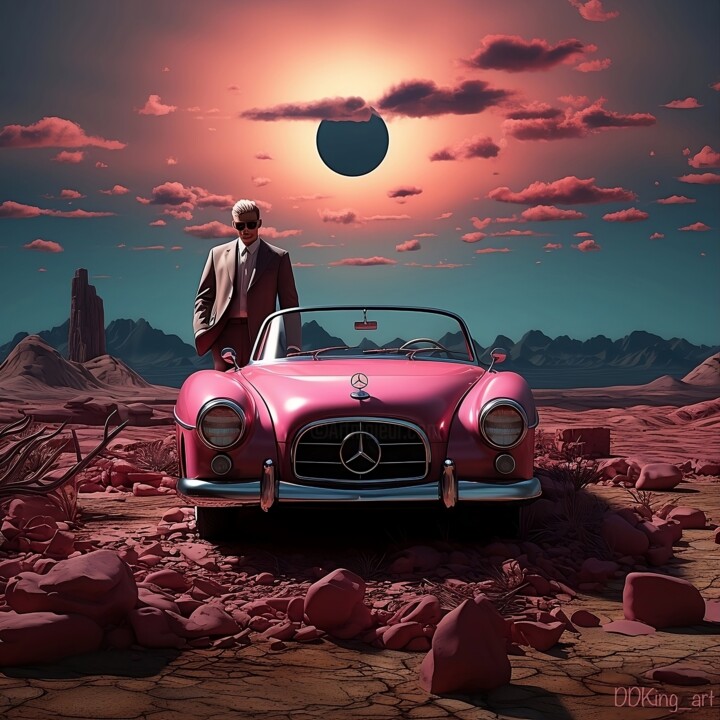
©2023 Ddking
Notable contemporary artworks
The contemporary art landscape is a dynamic patchwork of diverse expressions and groundbreaking ideas, each artwork a unique dialog with its audience. Here are a selection of some renowned contemporary artworks, spanning various media such as painting, sculpture, photography, drawing, printmaking, textile art, and digital art, that have profoundly influenced this vibrant movement.
"Cloud Gate" by Anish Kapoor, 2006 - This monumental stainless steel sculpture, also known as "The Bean," mirrors and distorts the Chicago skyline and onlookers in its seamless, liquid-like surface, creating an interactive experience that blurs the line between the artwork and the viewer.
"Marilyn Diptych" by Andy Warhol, 1962 - An iconic piece of pop art, this silkscreen painting features fifty images of Marilyn Monroe. Half brightly colored, half in black and white, it reflects the dichotomy of celebrity life and its influence on popular culture.
"Rhein II" by Andreas Gursky, 1999 - This photographic artwork, a digitally-altered image of the Rhine River, is celebrated for its minimalist aesthetic. It strips the landscape to its bare essentials, invoking a sense of tranquility and vastness.
"Black Square" by Kazimir Malevich, 1915 - A revolutionary painting in the realm of abstract art, this piece, featuring nothing more than a black square on a white field, challenges traditional notions of representation, symbolizing a new era in artistic expression.
"Puppy" by Jeff Koons, 1992 - This giant sculpture, a West Highland Terrier blanketed in flowering plants, explores themes of innocence, consumer culture, and the interplay between high art and kitsch. It’s a delightful blend of traditional sculpture and garden craft.
"Re-projection: Hoerengracht" by Ed and Nancy Kienholz, 1983-1988 - A room-sized tableau representing Amsterdam’s red-light district, this work combines elements of sculpture, painting, lighting, and found objects. It engages viewers in a stark commentary on commodification and objectification.
"Untitled" (Your body is a battleground) by Barbara Kruger, 1989 - This photomontage, combining black-and-white photography with impactful text, explores issues of feminism, identity, and power. Its potent, confrontational message is a prime example of the power of text in contemporary visual art.
"For the Love of God" by Damien Hirst, 2007 - This sculpture, a platinum cast of a human skull encrusted with 8,601 diamonds, probes themes of mortality, value, and the human fascination with luxury and decadence. It’s a compelling blend of macabre and magnificence.
"Physical impossibility of Death in the Mind of Someone Living" by Damien Hirst, 1991 - This artwork, featuring a tiger shark preserved in formaldehyde, blurs the line between traditional sculpture and biological specimen. It prompts viewers to contemplate mortality and nature’s ferocity.
"One and Three Chairs" by Joseph Kosuth, 1965 - A piece of conceptual art, it presents a physical chair, a photograph of a chair, and a dictionary definition of a chair, thus exploring the relationship between language, picture, and referent in art.
These pieces, in their diversity, exemplify the rich tapestry of contemporary art, each piece a unique commentary on our world and a testament to the limitless potential of creative expression.

Ddking
Digital Arts | 19.7x19.7 in




